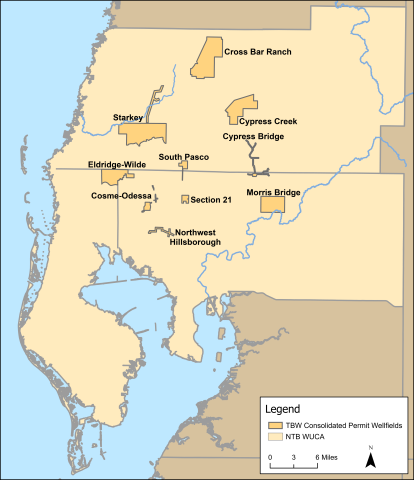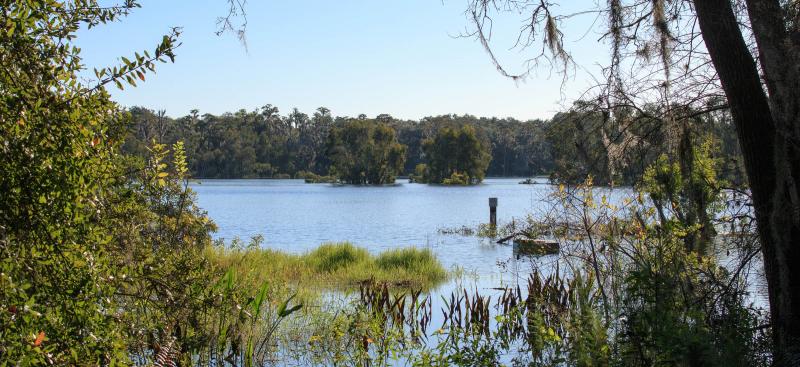The Northern Tampa Bay Water Use Caution Area (NTB WUCA) includes all of Pinellas and Pasco counties, and the majority of Hillsborough County.

Project Description
The Northern Tampa Bay Water Use Caution Area (NTB WUCA) was initially established in 1989 and expanded in 2007 to protect water resources from adverse impacts from groundwater withdrawals and from rapid growth and development pressures in the region. The majority of groundwater use in the NTB WUCA is for public supply from the Tampa Bay Water regional utility network.
Tampa Bay Water (TBW) and its member governments entered into an agreement with the Southwest Florida Water Management District (District) in 1998 (referred to as the Partnership Agreement) to significantly reduce groundwater withdrawals from its regional wellfields and work toward recovery in areas where water resources had been impacted. As part of the Partnership Agreement, the District combined all the permits for TBW’s central system wellfields into one permit (Water Use Permit No. 20011771), known as the “consolidated permit.” Over the years, the District has provided more than $300 million, which has been used in joint efforts to study the area and develop alternative water supplies.
Reductions Through Permitting
Before the consolidated permit was issued in 1998, collectively there was a total permitted annual average of 192 million gallons per day (mgd) of groundwater withdrawals for the 11 wellfields in the area. The original consolidated permit was issued for 158 (mgd) with plans to reduce withdrawals to 121 mgd by 2003 and 90 mgd by 2008. Reductions were achieved through the development of alternative water supplies. In 2010, the District’s Governing Board adopted the second phase of the recovery strategy and has since continued to evaluate the amount of environmental recovery achieved while withdrawals remain at or below 90 mgd.
Recovery Plan
The District established MFLs in the NTB area for cypress wetlands, lakes, rivers, springs and the Upper Floridan aquifer beginning in the late-1990s. Phase One (approved in 1999) required that new withdrawals not violate established MFLs, unless the withdrawal was part of the NTB WUCA Recovery Strategy. Phase Two was approved in 2009 for implementation through 2020.
Since the approval of the recovery plan, TBW has implemented three projects including Big Fish Lake Augmentation, Cross Bar Ranch Wellfield Wetlands Restoration and Cypress Creek Surface Water Management Project, which benefit up to 745 acres of wetlands. An additional eight projects are in development.
Alternative Water Supply Projects
Several approaches were taken by the District and TBW to develop alternative water sources for the Tampa Bay area, including building the largest seawater desalination plant in North America located in Apollo Beach, pulling water from various river sources, constructing a regional offstream reservoir in southern Hillsborough County, installing many miles of pipelines to connect systems, and completion of a surface water treatment plant. These alternative water resources have helped tremendously to compensate for the reduction in groundwater withdrawals and the rise in demand for water due to population growth in the area. These alternative sources also provide resiliency, allowing Tampa Bay Water flexibility in its water source so that resources can be rested before they become stressed.
Minimum Flows and Levels within the NTBWUCA
The District has established minimum flows and levels (MFLs) at approximately 30 wetlands, 71 lakes, two springs, three rivers and seven aquifer sites in NTB. All MFLs in the area are meeting levels except for one wetland located on the Morris Bridge wellfield and the Lower Hillsborough River (LHR) at the City of Tampa’s Dam location.
NTB Recovery Plan a Success
District staff conducted a hydrologic assessment of the Northern Tampa Bay wellfield recovery in August and September of 2020. The assessment indicated that by reducing groundwater withdrawals by about 50 percent since the 1990s, improved rainfall conditions, and implementation of a robust wellfield operations strategy by TBW that prioritized environmental preservation, all MFL lakes and all but one MFL wetland (located on the Morris Bridge wellfield) were meeting their levels, the ecological health of lakes and wetlands had significantly improved, and aquifer water levels were near their highest elevations in four to six decades.

